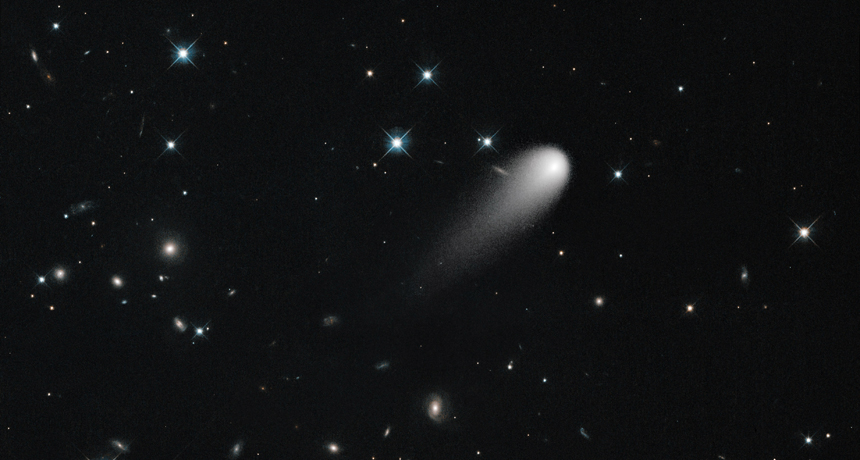The comet that came in from the cold
By Thanksgiving 2013, Comet ISON will either slingshot around the sun or be ripped apart

Comet ISON is headed for the sun. The Hubble Space Telescope captured this snapshot of it in April.
NASA/ESA/STSCI/AURA/HUBBLE HERITAGE
A chunk of frozen rock and ice about the size of a mountain is hurtling toward the sun. By the end of November 2013, this Comet ISON will get perilously close to our star. Astronomers don’t yet know if the sun’s gravity will rip apart the comet or boomerang it back into space. It’s also unclear how much of a spectacle ISON will offer stargazers. But for astronomers, the comet is already providing a brief, unprecedented glimpse of what the infant solar system looked like.
Russian astronomers Vitali Nevski and Artyom Novichonok discovered the comet on Sept. 21, 2012. They were using a telescope near Kislovodsk. Back then, ISON was still beyond the orbit of Jupiter. After the comet’s discovery, scientists began scouring earlier telescope observations. That’s when they found images showing it had been approaching, unnoticed, for months. By charting where the comet had been, scientists began plotting where its path would take it.
Astronomers have now spent more than a year watching ISON. And as of Nov. 5, they estimated it was racing toward the sun at nearly 45 kilometers per second (almost 28 miles per second). That’s fast enough to travel from New York to London in about two minutes. And day by day its speed has been building.
The comet accelerates as it approaches the sun, pulled by its gravity. Astronomers predict the comet will reach its closet point to the sun — what’s known as perihelion — just as many U.S. families sit down on Nov. 28 to their Thanksgiving dinner.
Out of the freezer
ISON probably came from the Oort cloud. This is a desolate region on the far outskirts of the solar system. Astronomer Matthew Knight calls the Oort cloud the “freezer of the solar system.” Knight is a comet researcher with the Lowell Observatory in Flagstaff, Ariz. ISON could give astronomers like him clues to the birth of the solar system, 4.5 billion years ago. “It’s the sort of thing I’ve been waiting for my whole career,” he told Science News.
Astronomers think frozen debris entered the Oort cloud about the time the rocky planets formed: Mercury, Venus, Earth and Mars. As such, Oort debris holds remnants of the infant solar system in cold storage. Every now and again, gravity from a passing star will nudge an Oort cloud object. That can send it hurtling into the inner solar system.
ISON is not the first Oort cloud object to get hurled toward the sun. However, it will come closer than earlier Oort cloud comets. As ISON warms, some of its gases will take on a fiery glow. Knight and other astronomers think the sun will continue to brighten ISON’s dust, gas and ice.
Early observations suggest ISON’s size is not unusual. Jian-Yang Li of the Planetary Science Institute in Tucson, Ariz., used images from the Hubble Space Telescope to study the object in April. His team found the comet’s body, or nucleus, is a rather typical 4 kilometers (almost 2.5 miles) in diameter.
ISON is releasing dust, as well as water vapor, carbon dioxide and carbon monoxide, astronomers reported Oct. 20 in Astrophysical Journal Letters. ISON’s gases probably had been frozen in the comet since the Oort cloud formed.
Not all scientists agree on the comet’s fate. Some argue it will eventually blaze brightly. Others believe it already has begun falling apart. Some even predict it will fizzle out before any dramatic fireworks start.
Knight and astronomer Kevin Walsh, of the Southwest Research Institute, in Boulder, Colo., wanted to predict ISON’s fate more scientifically. The two ran a computer program to simulate the comet’s path. In the Oct. 10 Astrophysical Journal Letters, they offered a fairly simple prediction: If the comet is spinning in one way, it will almost certainly hold together. If it’s spinning another way, it could break apart.
Whatever happens, its early detection and long journey already have made ISON one of the most studied comets in history. “This is a very special comet,” Li told Science News.
POWER WORDS
astronomy The area of science that deals with celestial objects, space and the physical universe as a whole. People who work in this field are called astronomers.
comet A celestial object consisting of a nucleus of ice and dust. When a comet passes near the sun, gas and dust vaporize off the comet’s surface, creating its trailing “tail.”
debris Scattered fragments, typically of trash or of something that has been destroyed. Space debris includes the wreckage of defunct satellites and spacecraft.
diameter The length of a straight line that runs through the center of a circle or spherical object, starting at the edge on one side and ending at the edge on the far side.
nucleus (in astronomy) The rocky body of a comet, sometimes carrying a jacket of ice or frozen gases.
Oort cloud A swarm of small rocky and icy bodies far beyond the orbit of Pluto, up to 1.5 light-years from the sun. The cloud is the source of some comets.
perihelion The point in the orbit of a planet, comet or other object at which it is closest to the sun.
solar system The eight major planets and their moons in orbit around the sun, together with smaller bodies in the form of dwarf planets, asteroids, meteoroids and comets.
telescope A light-collecting instrument that makes distant objects appear nearer through the use of lenses or a combination of curved mirrors and lenses. Some, however, collect radio emissions (energy from a different portion of the electromagnetic spectrum) through a network of antennas.







